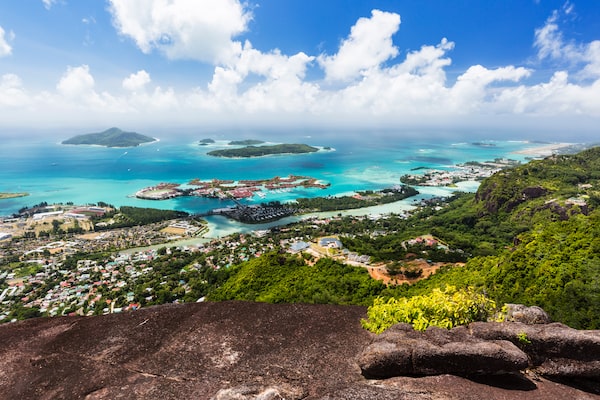
A view from Mount Copolia over the east of Mahe, in the Seychelles.Michael Utech/iStock
It is no hyperbole to declare the Seychelles drop-dead gorgeous. Dark granite formations shape the landscape; aromas of cinnamon and guava fill the air; vivid blooms of hibiscus, orchids and frangipani colour vistas and the legendary coco de mer palm trees thrive in a lusciously green jungle. And that’s just on land. Giant turtles, whale sharks, clown fish and rainbow runners populate the underworld of the deep blue Indian Ocean.
No surprise, this 115-island archipelago has become a playground for the one per cent. George and Amal Clooney reportedly spent $80,000 on their honeymoon here and other famous guests include the Beckhams, the Duke and Duchess of Cambridge, Salma Hayek, Jennifer Aniston, Gabrielle Union and Brad Pitt. Three-star hotels typically start at $300 and waterfront luxury resorts can run up to $2,600 a night. It may be 1,500 kilometres off the coast of East Africa, but the costs are closer to the Côte d’Azur.
Thanks to Airbnb and a growing guesthouse scene, the islands are becoming a more welcoming place for budget travellers. If you’re up for trying the funky municipal buses, eating take away curries and snacking on coconut meat on the beach, you can enjoy most Seychelles splendours.
I headed to the islands with little more than a light backpack, a bikini, a good pair of shoes and a budget of just $100 a day. Despite such frugal means, I never felt deprived of tropical bliss. It was quite the opposite: Exploring by foot and bus allowed us to chat with locals, find secret beaches and enjoy mouthwatering local treats. It was 10 blissful days of island hopping, glamping, flower smelling, snorkelling and floating in blue lagoons.
Marvellous Mahé
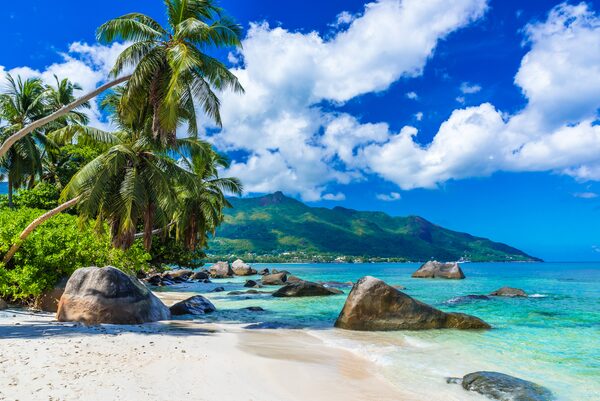
The gorgeous beach of Beau Vallon, known as the Saint-Tropez of the Seychelles.Simon Dannhauer/iStock
My travel companion and I begin by basing ourselves on the west coast of Mahé island and on a warm Monday evening in April find ourselves on a patio enjoying a warm breeze and the company of Clivy and Carol Albert, the owners of our guesthouse. I want to know more about the spices and herb mixture used in our splendid dinner of octopus salad and grouper à la seychelloise (cinnamon and curry leaves, freshly picked in the backyard garden) and, in return, Carol has many questions about my hometown of Montreal, where she lived as a child in the 1990s. The conversation flows easily and the only distraction is the spectacle of the Indian Ocean swallowing the large orange sun.
The friendly couple offer two spacious and comfortable flats on the first floor of their cozy home, nestled in the mountains of Barbarons, a town on the west coast of Mahé, from around $100 a night. Precious Residence, as it is called, is the exact opposite of the exclusive and prohibitively pricey (for me, at least) nearby resort where Carol works. She invites me to peek at pictures on her phone, so I can admire the infinity pool, luxurious cabanas and breathtaking view that constitute her daily working environment. “It’s beyond all inclusive," she says. "You can literally eat everything you want, anytime you want.”
For us, limitless luxury comes in the form of $1 fares for a seat in one of the big blue buses that drive around the narrow and often steep and bumpy roads of the islands. Our first outing on public transit brings us to Pointe au Sel, a small beach on the other side of Mahé. We set up camp on the white sand, test the warm and salty water, get into flotation mode and prepare to hang out there for hours. Later, we spot a beach patio on the horizon and make our way to the cute and colourful Kafe Kréol where we order salade du lagon – octopus, shrimps, fish with tomatoes, lettuce and cucumbers – served by a waiter who’s keen to tell us the differences between the Mauritian and the Seychelles Creole vernacular.
After that successful outing we become regulars of the big blue bus routes that start in Victoria, the capital. We make our way to Morne Seychellois National Park, where we spend a few hours before heading first to Sainte Anne Marine National Park and then Baie Ternay Marine National Park and later enjoy the gorgeous beach of Beau Vallon, known as the Saint-Tropez of the Seychelles.
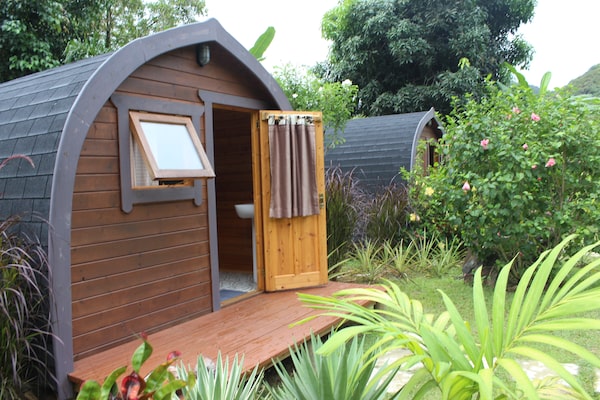
An air-conditioned cabana at Peace in Paradise, surrounded by the lush jungle.Sylvie St-Jacques/The Globe and Mail
After a few days we move on to Anse-à-la-Mouche in southwest Mahé where, for $90 a night, we glamp in a cozy air-conditioned cabana at Peace in Paradise. The jungle surrounds us and mangoes, guavas, papayas, pineapples, bananas, avocados, oranges, coconut trees and numerous spices and flowers bloom in abundance.
The owner, Erade Pool, is a Seychelles citizen in her 50s who designed her quaint property as a counterpart to the dominant large resorts. She planted the tropical garden herself, with respect for the living environment. “The Seychelles is a beautiful country, but unfortunately, many forests, indigenous plants and corals have been destroyed," she explains. "On my property, I wouldn’t cut a tree, if I knew there was a bird who lives in it. I would put my cabana somewhere else.”
Precious Praslin
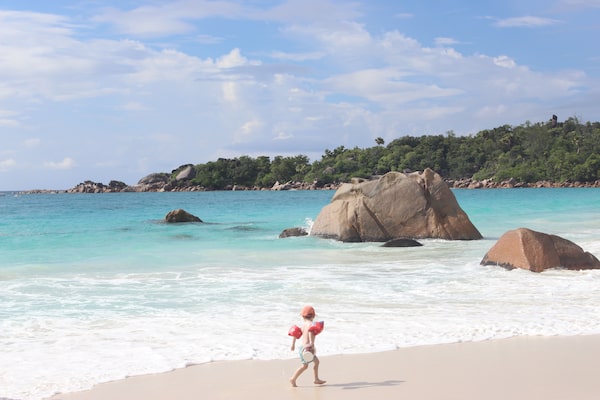
Anse Lazio, often cited among the best beaches in the world, is definitely worth a visit.Sylvie St-Jacques/The Globe and Mail
By day five, we have grown accustomed to life in paradise. We board a ferry that takes us to Praslin, 44 km northeast of Mahé. The tiny island is known as the home of the famous coco de mer palm trees, whose buttock-shaped nuts spurred more than a few racy legends.
We are lured by guidebook claims that Praslin, with its coquettish artsy villages and deep blue lagoons, delivers the most quintessential sea views associated with the Seychelles. With no time to waste, we drop our bags at the guesthouse and find the bus that goes to Anse Lazio, routinely ranked one of the 10 most beautiful beaches in the world. Swimming in its scintillating, crystal-clear waters is an ecstatic and unforgettable experience.
The next day, we opt for a snorkelling outing around tiny Saint-Pierre Island, where we spot a few colourful striped surgeonfish and large trevallies. Although we marvel at the warm and transparent waters, it’s sad to witness this white coral cemetery, destroyed during the heatwave-sparked 2016 coral-bleaching event, which also killed huge swaths of the Great Barrier Reef. But here and there, we do spot signs of recovery.
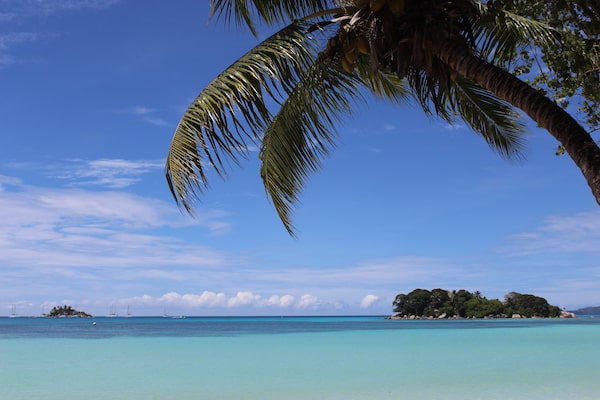
The beautiful blue waters at the Côte d'Or beach on Praslin.Sylvie St-Jacques/The Globe and Mail
Back on Praslin, we walk in the Vallée de Mai, a nature reserve and UNESCO World Heritage Site and spot a black parrot, observe giant turtles mating and photograph a billboard urging against coco de mer poaching. We stock up on curry spices and bottles of Takamaka Rum, hang out on the beautiful Côte d’Or beach and spend our last rupees on a dinner of octopus curry in Grand Anse, a town on the southern coast of Praslin
We say goodbye to the islands, basking in the memory of our time in pure paradise.
Your turn
Flight
You’ll have to take at least two planes to travel the roughly 13,000 kilometers that separate the Seychelles from Toronto. We took Ethiopian Airlines and flew via Addis Ababa. The last time we checked, this company was offering the best value for the 18-hour flight.
Vaccination and health concerns
The archipelago has been protected from tropical diseases such as malaria, typhoid fever, cholera or yellow fever. Avoid drinking water from the tap and don’t forget the mosquito repellent. With all year round temperatures between 25 C and 30 C, make sure to stay well hydrated.
Do not forget
Snorkelling gear, sunscreen, binoculars for bird watching and a good pair of (ideally waterproof) sandals.
Budget
We spent an average of $100 a day each on this backpacking tour of the Seychelles. We managed to do so by taking public buses instead of renting a car, packing a lunch and preparing dinners of fresh fish at our guesthouses. Some bus drivers don’t allow commuters with luggage, so you might want to plan a taxi from and to the airport.
Do you speak Seychelles?
Créole, French and English are the three official languages of the islands.